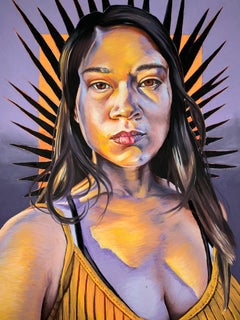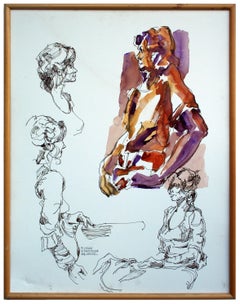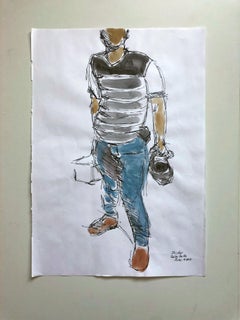Foam Board Portrait Drawings and Watercolors
to
1
1
1
Overall Width
to
Overall Height
to
1
1
1
1
2
2
2
2
1
1
98
1,576
1,463
1,291
1,187
1
1
2
Medium: Foam Board
"I Atdao Giya Texas (Texas Sun)", Contemporary, Portrait, Figure, Purple, Pastel
By Fu'una
Located in Franklin, MA
Fu’una’s “I Atdao Giya Texas (Texas Sun)” is a contemporary self portrait completed in pastel. The figure is shown with Texas golden hour sun on her face and a palm motif projecting ...
Category
2010s Contemporary Foam Board Portrait Drawings and Watercolors
Materials
Pastel, Paper, Foam Board
Portrait Study
Located in Soquel, CA
Unique set of expressive portrait studies in watercolor and ink by Santa Cruz artist Bob Newick (American, 20th Century). Signed "To Wendy / In Friendsh...
Category
Late 20th Century American Impressionist Foam Board Portrait Drawings and Watercolors
Materials
Ink, Watercolor, Foam Board
$700 Sale Price
20% Off
Related Items
Contemporary Drawing "Blue Prayer" Draw, Pastel, Ink And Colored Pencils
Located in Bogotá, Bogotá
Drawing, pastel, Pencil, Petal Flowers, Color and Ink on Paper.
The base of this drawing is ordinary yellow paper of 80 gr. I use natural dyes from flowers, herbs, leaves, and tree ...
Category
2010s Contemporary Foam Board Portrait Drawings and Watercolors
Materials
Paper, Pastel, Ink, Pencil, Color Pencil
Jaider Portrait. Watercolor, Ink and Pastel on Archival Paper.
Located in Miami Beach, FL
Drawing on paper is his basic work tool, some are sketches of his surviving works, others are sketches of moments he documents.
Undefined by medium, Celso Castro’s works each carry...
Category
2010s Contemporary Foam Board Portrait Drawings and Watercolors
Materials
Ink, Paper, Pastel, Watercolor
$400
H 19.5 in W 13.75 in D 0.1 in
Cuban Artist - Caricature of Adolphe Menjou Debonair Devil
Located in Miami, FL
Framed Cuban Artist/Caricaturist Conrado Walter Massaguer presents Hollywood star Adolphe Menjou in a satirical dual portrait. In the foreground, the subject is seen in a dapper top hat, tux, fashionable cigarette and boutonnière, and is shown as being the epitome of being stylishly debonair. To make a larger point about this subject, Massaguer paints a cast shadow of Menjou as a burning red devil who studies his alter ego from above. Keeping with the artist's sarcasm, we see the good and bad in one image. Works by Massaguer are rare and this work is in keeping with his signature style. This work was most likely done on assignment for Life Magazine, Cosmopolitan, The New Yorker or Vanity Fair. Signed upper right. Inscribe lower right. Titled on verso. Unframed, Slight bend to board; toning to board; scattered faint foxing; pin point abrasions to margins, not affecting image. 19-1/2 x 15-1/8 inches board size.
Conrado Walter Massaguer y Diaz was a Cuban artist, political satirist, and magazine publisher. He is considered a student of the Art Nouveau. He was the first caricaturist in the world to broadcast his art on television.He was first caricaturist to exhibit on Fifth Avenue. He was the first caricaturist in the world to exhibit his caricatures on wood. He, and his brother Oscar, were the first magazine publishers in the world to use photolithographic printing.
Self portrait of Conrado Walter Massaguer, depicted on a carrousel ride, with the devil over his left shoulder and an angel over his right. (1945)
He created the magazine Social with his brother Oscar to showcase Cuban artistic talent. The duo later created the magazine Carteles, which became for a period the most popular magazine in Cuba, which was purchased by Miguel Ángel Quevedo in 1953.
In his life, he met and drew caricatures of Franklin D. Roosevelt, Walt Disney, Albert Einstein, the King of Spain, and many others.[ In sum total, he was the author of more than 28 thousand caricatures and drawings.Ernest Hemingway once had to refrain himself from punching Massaguer in the face after the artist drew an unflattering caricature of him. The dictator Gerardo Machado, however, did not punch Massaguer for his own unflattering caricature - he had the artist deported.
He was one of the most internationally renowned Cuban artists of his day, and his art is still regularly featured in galleries across the Western Hemisphere and Europe.
Early life
Massaguer was born on October 18, 1889, in Cárdenas, Cuba.[In 1892, his family moved to Havana.
When the Cuban War of Independence broke out, Massaguer's family escaped the country. From 1896 to 1908, he lived in Mérida, Mexico. However, during this time, his parents enrolled him in the New York Military Academy, where he stayed during school years.
In 1905, after graduating the military academy, he briefly attended the San Fernando school in Havana, where he was tutored by Ricardo de la Torriente and Leopoldo Romañach.
In 1906, less than a year later, he returned to the family home in Mexico.
Career as artist
Early career
While living in Yucatán, Mexico, Massaguer published his first caricatures in local newspapers and magazines. These included La Campana, La Arcadia, and the Diario Yucateco.
In 1908, he moved back to Havana. After returning to the island in 1908, Massaguer began mingling with Havana's aristocratic circles, forming close friendships with some of the city's most powerful and influential men, as well as winning the favor of many women who were quickly charmed by him. Massaguer, largely self-taught, honed his style using the avant-garde techniques he studied from the European and American magazines that were widely available in Cuba at the time.
Cover of the immensely popular Cuban magazine El Figaro, drawn by Massaguer in 1909. This cover depicts two bumbling, incompetent American tourists to the island.
He started drawing for El Fígaro, and was featured prominently on the cover in 1909.
After two years of refining his craft, Havana announced a poster contest aimed at attracting North American tourists to stay in the city during the winter months. Notable figures like Leopoldo Romañach, Armando Menocal, Rodríguez Morey, Jaime Valls, and others also entered the competition. The jury was particularly impressed by the modern execution and creative solution of one piece, signed by Massaguer, who was relatively unknown at the time.
The jury deliberations caused a great controversy.[5] The prize was ultimately awarded to the Galician painter Mariano Miguel, who had recently married the daughter of Nicolás Rivero, the wealthy owner of the conservative newspaper Diario de la Marina. Although Massaguer received only an honorable mention, the fraud scandal caused such an uproar that his name quickly entered the public spotlight, and he became an overnight sensation.
In 1910, he became co-owner of the advertising agency Mercurio, with Laureano Rodríguez Castells. At Mercurio, he led the Susini cigar campaign, and earned substantial wealth.
Massaguer has been described as a restless man, in both mind and body.After earning enough money from his art to begin traveling, he was almost always doing so. He constantly traveled between New York City and Havana, Mexico and France, Europe and the Americas.
In 1911, his reputation among the Havana socialites solidified when he organized his own first public caricature exhibit, and also the first Caricature Salon ever held in the Americas, hosted at Athenaeum of Havana (the Ateneo), and the Círculo de La Habana. Other exhibitors here included Maribona, Riverón, Portell Vilá, Valer, Botet, Barsó, García Cabrera, Carlos Fernández, Rafael Blanco, and Hamilton de Grau.
"Messaguer Visits Broadway." Caricatures of theatrical and literary figures. Elsie Janis, Raymond Hitchcock, S. Jay Kaufman (columnist), Ibanez, author of The Four Horsemen, and Frances White
In 1912, in the New York American Journal, he published his first Broadway drawings.
From 1913 to 1918, he was an editor for Gráfico.
Social
Main article: Social (magazine)
Cover of the magazine Social, July 7, 1923
In 1916, he created the magazine Social with his brother, Oscar H. Massaguer. Social's contributors included Guillén Carpentier, Chacón y Calvo, Enrique José Varona and others.Social has been described as Massaguer's great love in the magazine industry, and was the property that historians say he cared the most about. Social was an innovative magazine, being the first magazine in the world to use a modern printing process called photolithographic printing.
Social set cultural trends, not only in the fashion of Cuba, but in art, politics, and Cuban identity.[11] Social catered to a certain aesthetic in Cuba - that of the sophisticated elite socialite - but Massaguer would also use this magazine to ridicule and jibe against that same class of society when he found their personalities worthy of his contempt.
In Social, readers could find a variety of content, including short stories, avant-garde poetry, art reviews, philosophical essays, and serialized novels, as well as articles on interior design, haute couture, and fashion. Occasionally, the magazine also featured reports on sports such as motor racing, rowing, tennis, and horse riding.The cultural promotion efforts of both Massaguer and Emilio Roig de Leuchsenring are evident in the magazine. Notably, this period overlaps with their involvement in the Minorista Group, which was then at the forefront of the country's intellectual life.[5] Many contributors were devoted members of the group, leading some experts to consider Social as the cultural voice of the Minoristas.
One of the features of Social magazine was its section called "Massa Girls," which was a play on his own name, and pronounced with a glottal 'g' in a similar fashion to the letter in Massaguer.[12] Massaguer drew women as independent and free-thinking, and never drew the woman celebrity as a caricature of herself, but as a free agent surrounded by caricatures.[11] However, Massaguer himself has been described as a womanizer in his personal life, and hesitant to fully embrace every facet of women's liberation.
In 1916, he also established la Unión de Artes Gráficas and the advertising agency Kesevén Anuncios.[9]
The art critic Bernardo González Barroa wrote:
“Massaguer has solved the problem of working hard, living comfortably off what his art produces and not missing any artistic, sporting or social event. His broad, childish laugh, of a carefree individual who carries his luck hidden in a pocket, appears everywhere for the moment, disguising the pranks of pupils that lurk, mock and, finally, flash with satisfaction at finding the characteristic point after having analyzed a soul... Massaguer's personality is beginning to solidify now. He has been the best-known and most popular caricaturist for a long time, but his technique had not reached the security, the mastery of values that he presents in his latest works, which is very natural and explainable”[5]
Carteles
Main article: Carteles
Cover of the magazine Carteles, November 29, 1931
In 1919, Massaguer and his brother created the magazine Carteles.[9] Carteles gained the widest circulation of any magazine in Latin America, and the most popular magazine in Cuba for a time, until that title was claimed by Revista Bohemia. Carteles remained in print until July 1960.This magazine showcased Cuban commerce, art, sports, and social life before the revolution.
In 1924, Carteles took a more political turn, with articles criticizing Gerardo Machado's government. it became a prime example of the humor and graphic design employed by artists like Horacio Rodríguez Suria and Andrés García...
Category
1930s Art Nouveau Foam Board Portrait Drawings and Watercolors
Materials
Watercolor, Ink, Illustration Board
$12,500
H 16.38 in W 12.5 in
Draw, pastel, Ink and Colored Pencils. "First day in eternity."
Located in Bogotá, Bogotá
Drawing, pastel, Pencil, Petal Flowers, Color and Ink on Paper. The base of this drawing is 120g/m2 Fabriano paper. I use natural dyes from flowers, herbs, leaves, and tree bark as t...
Category
2010s Contemporary Foam Board Portrait Drawings and Watercolors
Materials
Paper, Pastel, Ink, Pencil, Color Pencil
Side Profile of Young African American Man with Black Hoodie
Located in Fredericksburg, VA
This pastel portrait captures the side profile of a young African American man dressed in a black hoodie. The artist skillfully employs the pastel medium to bring out the rich textur...
Category
21st Century and Contemporary Contemporary Foam Board Portrait Drawings and Watercolors
Materials
Paper, Pastel
Carlos. Martes 24 de Mayo, Drawing
Located in Miami Beach, FL
Drawing on paper is his basic work tool, some are sketches of his surviving works, others are sketches of moments he documents.
Undefined by medium, Celso Castro’s works each carry...
Category
1990s Contemporary Foam Board Portrait Drawings and Watercolors
Materials
Pastel, Pencil, Paper
The girl from Saint Tropez: American artist in the South of France portrait
Located in Norwich, GB
Alexander Warshawsky was born in Cleveland, Ohio on March 29, 1887. He studied painting at the Cleveland School of Art and the National Academy of Design in New York City. Warshawsky...
Category
1920s American Impressionist Foam Board Portrait Drawings and Watercolors
Materials
Paper, Gouache
$800
H 16.54 in W 12.6 in D 0.4 in
"Untitled 10, " Watercolor Painting
Located in Denver, CO
Clyde Steadman's "Untitled 10" is an original, handmade watercolor painting that depicts an impasto portrait of a feminine face.
Category
2010s American Impressionist Foam Board Portrait Drawings and Watercolors
Materials
Paper, Watercolor
Poncho Jueves 26 de Mayo, Framed Drawing
Located in Miami Beach, FL
Drawing on paper is his basic work tool, some are sketches of his surviving works, others are sketches of moments he documents.
Undefined by medium, Celso Castro’s works each carry...
Category
1990s Contemporary Foam Board Portrait Drawings and Watercolors
Materials
Pastel, Pencil, Paper
MY SLEEPING BEAUTY
Located in Aventura, FL
Original pastel on paper. Hand signed on front; signed, titled and dated on verso. Visible image size: approx. 18.5 x 25.5 in. Frame size: 29 x 36 in. Artwork is in excellent conditi...
Category
1970s Contemporary Foam Board Portrait Drawings and Watercolors
Materials
Paper, Pastel
[Woman at a Table]
Located in Boston, MA
Frederick Bosley was an Impressionist painter of the Boston School who most often depicted portraits, figures and still-lifes. The artist was born in Lebanon, New Hampshire in 1881. He studied at the Museum School in Boston from 1900-1906 with Edmund C. Tarbell (1862-1938) and Frank W. Benson (1862-1951), and then in Europe from 1906-1908. Bosley returned to Boston in 1909, obtaining a studio at the Fenway Studios from 1909-1918. He was to become a teacher in his own right, settling as Director at the Museum School from 1913-1931. His many awards include First prize in the 1920 Concord Art Academy Exhibition and a Gold Medal in the Pennsylvania Academy of Fine Arts Exhibition, 1925. His work may be found in the collections of several institutions, including the Boston Museum of Fine Arts, the Farnsworth Museum, the National Academy of Design and the Concord Academy...
Category
Early 20th Century American Impressionist Foam Board Portrait Drawings and Watercolors
Materials
Paper, Pencil
Hiawatha's Honeymoon - Heroic Pose at Sunset
Located in Miami, FL
In a heroic standing pose on a cliff, set against the grandeur of nature, female illustrator Adelaide Hiebel depicts an idealized double portrait of Hiawatha and her husband, Minneha...
Category
1930s American Impressionist Foam Board Portrait Drawings and Watercolors
Materials
Canvas, Pastel
Foam Board portrait drawings and watercolors for sale on 1stDibs.
Find a wide variety of authentic Foam Board portrait drawings and watercolors available on 1stDibs. While artists have worked in this medium across a range of time periods, art made with this material during the 20th Century is especially popular. There are many well-known artists whose body of work includes ceramic sculptures. Frequently made by artists working in the Impressionist, all of these pieces for sale are unique and many will draw the attention of guests in your home. Not every interior allows for large Foam Board portrait drawings and watercolors, so small editions measuring 0.1 inches across are also available Prices for portrait drawings and watercolors made by famous or emerging artists can differ depending on medium, time period and other attributes. On 1stDibs, the price for these items starts at $67 and tops out at $1,250,000, while the average work can sell for $638.
Recently Viewed
View AllMore Ways To Browse
Peter Max Etching
Pichet Espagnol
Playboy Posters Vintage
Poster Corse Vintage
Punk Rock Posters
Remy Hetreau
Richard Bowman
Robert Glen
Robert Henry Roe
Robert Marsh
Robert Thomas Paintings
Roger Worms
Roy Lichtenstein Triptych
Saint Croix
Salvador Dali Bust
Salvador Dali Watch
Sandy Hook Painting
Sanford Sculpture


